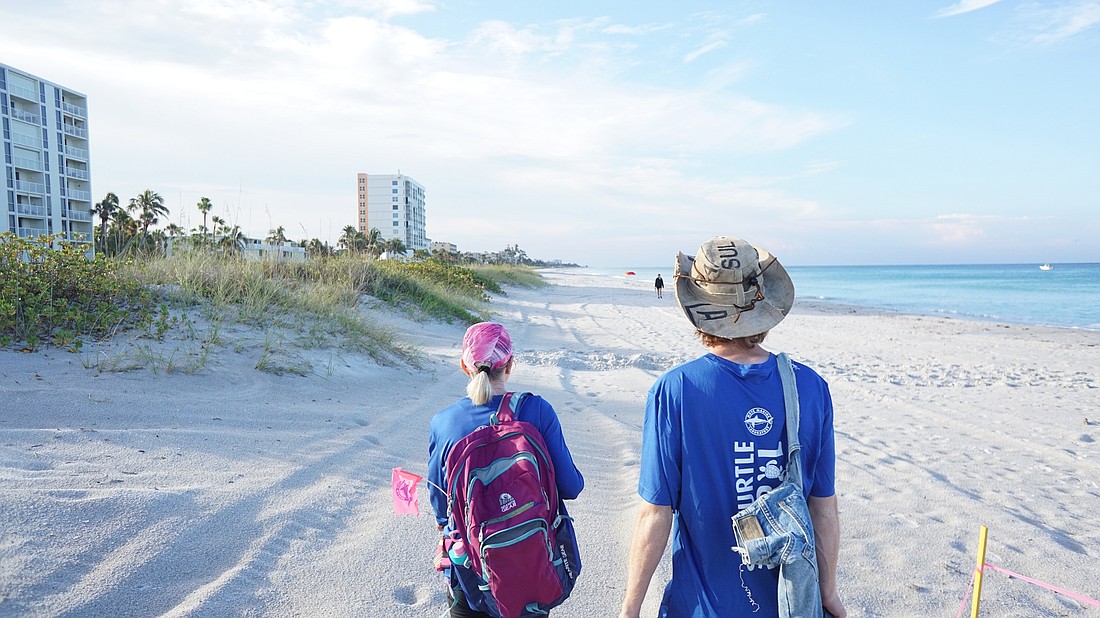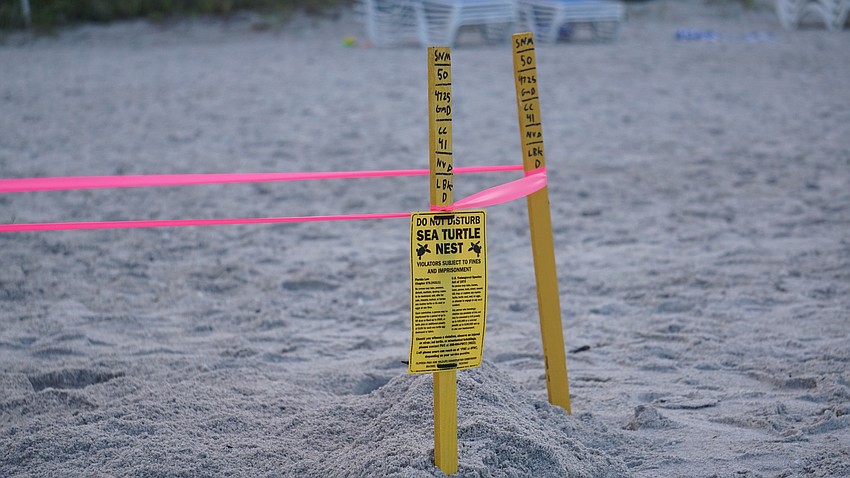- July 26, 2024
-
-
Loading

Loading

The sun peeked through the horizon just before 6:45 a.m., providing backlight for the Turtle Watch volunteers and spectators gathered at the 4795 Gulf of Mexico Drive beach access. Cool wind whipped from the ocean and over the dunes, bringing with it the smell of saltwater.
Connie Schindewolf and her team were on the beach an hour before the first turtle walk event on June 4. She has been volunteering with Longboat Key Turtle Watch since 1983.

Schindewolf often works alongside the Jameson family during these mornings. They are also volunteers with Longboat Key Turtle Watch and the youngest, Caleb, just graduated high school. He has been volunteering with the organization since he was 8 years old.
The four of them patrol Zone D and mark the previous night’s nests before the actual turtle watch event begins. Their zone covers about a 1.5 miles and Longboat Key Turtle Watch’s full coverage area spans a little over 4 miles, from Greer Island to the Sarasota County line. Mote Marine Laboratory covers the rest of Longboat Key in Sarasota County.
“We usually have something,” she said as she began her introduction to the morning’s crew. With this year’s nesting season, that would be a safe bet.

Nesting season officially began on May 1. As of June 3, the total number of nests on Longboat Key was 307. At that same time in 2022, the total nests on Longboat was 248. The year before that, it was 165.
On June 4 they recorded seven activities in their zone. Activities include both nests and false crawls, which are events when a turtle crawls up the beach but does not actually lay eggs. Schindewolf recalls the highest number of activities she’s ever seen in one day was 23, while Caleb said 28.
At the nest closest to the start of the walk, Caleb began labeling stakes with nest info as Schindewolf talked to the audience. Brenda Jameson, Caleb’s mother, took GPS coordinates of the nest and drew a diagram of the location and turtle tracks. The four stakes were then driven into the sand, making a square over the nest.

When the talk is over and the nest is properly tracked, the audience is dismissed. Schindewolf and the Jamesons are then responsible for marking the remaining nests in their zone. With their combined experience, tracking seven activities was like clockwork. Brenda and her husband took one end of the zone while Schindewolf and Caleb handled the other.
After four decades of volunteering, Schindewolf is able to see how their work can make a large impact.
“The most rewarding part is knowing that you may not just be saving a turtle, but that you might be influencing a whole population,” Schindewolf said.
Longboat Key Turtle Watch is permitted under Mote Marine Laboratory, where the research is based. Melissa Macksey has been the Sea Turtle Conservation manager with the program since 2018.
“We’re off to a really good start this year,” Macksey said.
However, Macksey warned that it’s still too early to tell how the season will go. Things could plateau or drop off at any point, according to Macksey. She said that warming waters have been altering nesting seasons over time due to the many cues sea turtles depend on in their nesting season.
Sea turtles use cues to determine much of their behavior, especially when it comes to reproduction. When the temperature starts to warm, they know that it is time to migrate back to their nesting grounds, find a mate and then nest. But, with global temperatures on the rise, increasingly warmer waters have led to early nesting seasons.
“They’re very complicated animals and there’s a whole bunch of stuff going into it, but the warmer waters do seem to be shifting the season earlier,” Macksey said.
Tracking the true number of nests laid also comes with caveats. Sea turtles could lay anywhere from four to eight nests in a single season. On top of that, many species take years off in between nesting, according to Macksey.
Once the eggs are laid, the turtles are completely on their own. The hatchlings receive no parental care to help guide them past beach chairs and towards the brightest horizon. In fact, they won’t even know their father. That’s one aspect “Finding Nemo” got wrong, Macksey said.
“They are counting on not being completely overrun by predators and for those beaches to be dark,” Macksey said.

Inland lighting can be a real problem, Macksey said. The hatchlings will travel toward the brightest horizon, which naturally should be the ocean. But, if the lights on shore are too bright, then the turtles might travel in the wrong direction. This wastes what little energy the hatchlings have coming from their yolk sac, a membrane that provides the embryo with nutrients prior to hatching. This energy is essential for their trip out to the ocean for about three days until reaching safety in the ocean's “seaweed line.” The hatchlings spend most of their juvenile life in this natural floating sargassum, using it as a refuge to eat and to hide from predators.
Hatchlings need to make it to the water by sunrise. If they lose their way and aren’t found in time by volunteers like those of the Longboat Key Turtle Watch, the hatchlings may dry out and die, according to Macksey.
Ordinances like the ones spelled out in Longboat Key’s Chapter 100 – Marine Turtle Protection aim to give the turtles the best chance at survival. Turning off unnecessary artificial lights after sunset, or using turtle-safe lighting is necessary during the nesting season. Additionally, any holes made on the beach must be filled and beach chairs must be stored and out of the way during nesting hours.
Code Enforcement Officer David Woods said that the city received 127 infraction notifications from May 1 to June 10. From that, 75 were lighting violations and 52 were because of obstructions on the beach. The process, he said, begins with a courtesy warning but could lead to the special magistrate for a court hearing if the infractions recur. Woods said he frequently goes on what he calls “turtle patrol,” either after sunset or before sunrise to check for potential infractions.
Ensuring the survival of these turtles is crucial, especially for loggerheads, according to Macksey. The southeast United States is home to the largest population of loggerhead turtles in the world. Of that population, 90% of the individuals nest in Florida, Macksey said.
Longboat Key Turtle Watch hosts free public turtle walk events every Saturday morning at 6:45 a.m. until the end of July. These events begin at 4795 Gulf of Mexico Drive. To stay up to date on the turtle nest count, visit Mote’s website or check out the front page of the Observer every week during the nesting season.